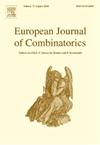On non-degenerate Turán problems for expansions
IF 1
3区 数学
Q1 MATHEMATICS
引用次数: 0
Abstract
The -uniform expansion of a graph is obtained by enlarging each edge with new vertices such that altogether we use new vertices. Two simple lower bounds on the largest number of -edges in -free -graphs are (in the case is not a star) and , which is the largest number of -cliques in -vertex -free graphs. We prove that . The proof comes with a structure theorem that we use to determine exactly for some graphs , every and sufficiently large .
关于膨胀的非退化图兰问题
图 F 的 r-uniform 扩展 F(r)+ 是通过用 r-2 个新顶点扩大每条边而得到的,这样我们总共使用了 (r-2)|E(F)| 个新顶点。关于无 F(r)+ r 图中 r 边的最大数量 exr(n,F(r)+) 的两个简单下限是 Ω(nr-1)(在 F 不是星形的情况下)和 ex(n,Kr,F),后者是无 n 个顶点的 F 图中 r 簇的最大数量。我们证明,exr(n,F(r)+)=ex(n,Kr,F)+O(nr-1)。该证明包含一个结构定理,我们用它来精确确定某些图 F、每个 r<χ(F)和足够大的 n 的 exr(n,F(r)+)。
本文章由计算机程序翻译,如有差异,请以英文原文为准。
求助全文
约1分钟内获得全文
求助全文
来源期刊
CiteScore
2.10
自引率
10.00%
发文量
124
审稿时长
4-8 weeks
期刊介绍:
The European Journal of Combinatorics is a high standard, international, bimonthly journal of pure mathematics, specializing in theories arising from combinatorial problems. The journal is primarily open to papers dealing with mathematical structures within combinatorics and/or establishing direct links between combinatorics and other branches of mathematics and the theories of computing. The journal includes full-length research papers on important topics.

 求助内容:
求助内容: 应助结果提醒方式:
应助结果提醒方式:


